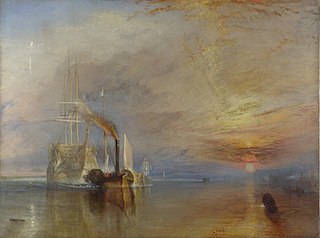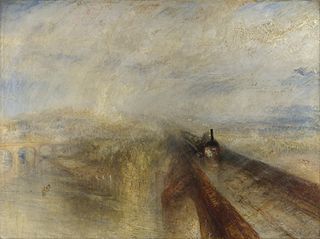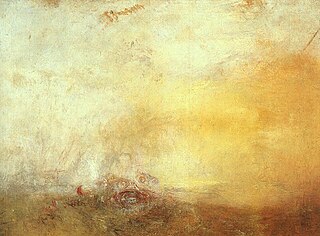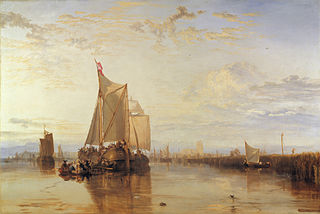This article relies largely or entirely on a single source .(April 2023) |

View on Clapham Common is a painting by J.M.W. Turner (23 April 1775 - 19 December 1851), painted c. 1800- 1805. [1]
This article relies largely or entirely on a single source .(April 2023) |

View on Clapham Common is a painting by J.M.W. Turner (23 April 1775 - 19 December 1851), painted c. 1800- 1805. [1]

Joseph Mallord William Turner, known in his time as William Turner, was an English Romantic painter, printmaker and watercolourist. He is known for his expressive colouring, imaginative landscapes and turbulent, often violent marine paintings. He left behind more than 550 oil paintings, 2,000 watercolours, and 30,000 works on paper. He was championed by the leading English art critic John Ruskin from 1840, and is today regarded as having elevated landscape painting to an eminence rivalling history painting.

The Fighting Temeraire, tugged to her last berth to be broken up, 1838 is an oil-on-canvas painting by the English artist Joseph Mallord William Turner, painted in 1838 and exhibited at the Royal Academy in 1839.

Rain, Steam, and Speed – The Great Western Railway is an oil painting by the 19th-century British painter J. M. W. Turner.

Modern Rome – Campo Vaccino is a landscape by British artist Joseph Mallord William Turner completed in 1839. It is Turner's final painting of Rome and had been in the possession of the family of the 5th Earl of Rosebery since 1878, until the painting came to auction, 7 July 2010. It was bought by the J. Paul Getty Museum, Los Angeles, and was subject to an export bar to allow a British gallery time to attempt to match the Getty's bid.

The Burning of the Houses of Lords and Commons, 16th October, 1834 is the title of two oil on canvas paintings by J. M. W. Turner, depicting different views of the fire that broke out at the Houses of Parliament on the evening of 16 October 1834. They are now in the Philadelphia Museum of Art and Cleveland Museum of Art.

Dido building Carthage, or The Rise of the Carthaginian Empire is an oil on canvas painting by J. M. W. Turner. The painting is one of Turner's most important works, greatly influenced by the luminous classical landscapes of Claude Lorrain. Turner described it as his chef d'oeuvre. First exhibited at the Royal Academy summer exhibition in 1815, Turner kept the painting until he left it to the nation in the Turner Bequest. It has been held by the National Gallery in London since 1856.

Sunrise with Sea Monsters is an unfinished oil painting by English artist J. M. W. Turner.

The Fifth Plague of Egypt is an 1800 oil painting by Romantic English artist Joseph Mallord William Turner currently in the permanent collection at the Indianapolis Museum of Art. Despite its title, it depicts Moses cursing the Egyptians with a plague of hail and fire, known as the seventh plague. It is one of the first works in which Turner uses an extreme representation of landscape and nature to explore the sublime.

The Fountain of Indolence is an oil painting by the English artist J. M. W. Turner. First exhibited in 1834, it is now in the collection of the Beaverbrook Art Gallery in Fredericton, New Brunswick, Canada.

Ulysses Deriding Polyphemus is an 1829 oil painting by Joseph Mallord William Turner. It depicts a scene from Homer's Odyssey, showing Odysseus (Ulysses) standing on his ship deriding Polyphemus, one of the cyclopes he encounters and has recently blinded, who is disguised behind one of the mountains on the left side. Additional details include the Trojan Horse, a scene from Virgil's Aeneid, on one of the flags and the horses of Apollo rising above the horizon. This painting is thought to be quickly done as a replacement for previous paintings submitted to the Academy that had been delayed. The painting was exhibited at the Royal Academy of Arts in 1829. Acquired by the National Gallery in 1856, the painting is on display in room 34.

Snow Storm, or Snow Storm: Steam-Boat off a Harbour's Mouth, is a painting by English artist Joseph Mallord William Turner (1775–1851) from 1842.

The Dort, or Dort or Dordrecht: The Dort packet-boat from Rotterdam becalmed is an 1818 painting by J. M. W. Turner, based on drawings made by him in mid September 1817. It shows a view of the harbour of Dordrecht. It is the finest example of the influence of Dutch marine painting on Turner's work.

Fishermen at Sea, sometimes known as the Cholmeley Sea Piece, is an early oil painting by English artist J. M. W. Turner. It was exhibited at the Royal Academy in 1796 and has been owned by the Tate Gallery since 1972. It was the first oil painting by Turner to be exhibited at the Royal Academy. It was praised by contemporary critics and burnished Turner's reputation, both as an oil painter and as a painter of maritime scenes.

Whalers is an 1845 painting by British artist J. M. W. Turner. Done in oil on canvas, the work depicts a whaling ship and her launches pursuing a whale. Originally created with the hope that collector Elhanan Bicknell would purchase it, the work is currently found in the collection of the Metropolitan Museum of Art.

Norham Castle, Sunrise is an oil-on-canvas painting by English painter J. M. W. Turner, created around 1845. The painting depicts Norham Castle, overlooking the River Tweed, the border between England and Scotland. The painting was bequeathed to the National Gallery of British Art as part of the Turner Bequest in 1856. It remains in the collection to this day. It was one of the artist's last paintings, and falls within his "Modernist" period. This piece is well known for Turner's attentiveness to dawn light, and the softened silhouette it brings.

The Golden Bough is a painting from 1834 by the English painter J. M. W. Turner. It depicts the episode of the golden bough from the Aeneid by Virgil. It is in the collection of the Tate galleries.

Venice, from the Porch of Madonna della Salute is a 19th century oil painting by J. M. W. Turner. Done in oil on canvas, the painting depicts an imagined image of Venice, as the view shown is not realistic. The painting was inspired by one of Turner's three visits to Venice, and showcases Turner's skill as a maritime artist. The work is in the collection of the Metropolitan Museum of Art.

Caernarvon Castle is a painting by J. M. W. Turner, painted c. 1798.

Peace – Burial at Sea is a painting in oils on canvas by the English Romantic artist J. M. W. Turner (1775–1851), first exhibited in 1842. The work is a memorial tribute to Turner's contemporary the Scottish painter Sir David Wilkie (1786–1841). The canvas depicts Wilkie's burial at sea. This work was intended as a companion piece to War. The Exile and the Rock Limpet which alludes to the sordid demise of the former Emperor of France Napoleon Bonaparte. The two works are characterized by sharply contrasting colors and tones: War utilizes a strident yellow and red while Peace is painted a cool blend of white, blue and black.

The Shipwreck is a landscape painting by J. M. W. Turner in the collection of the Tate. It was completed around 1805, when it was exhibited in Turner's own gallery. The painting is an important example of the sublime in British art.